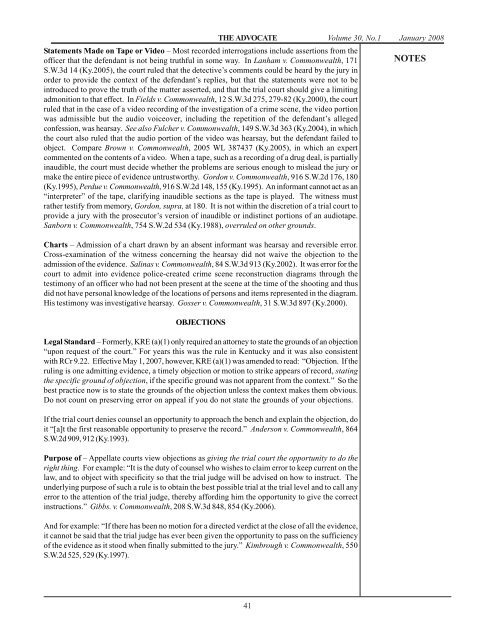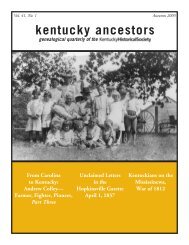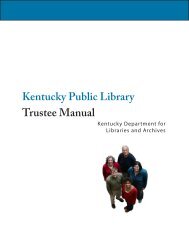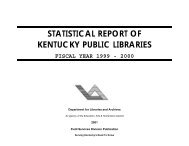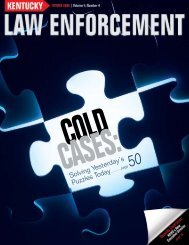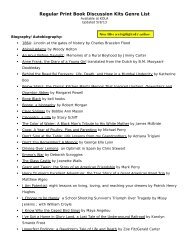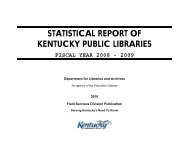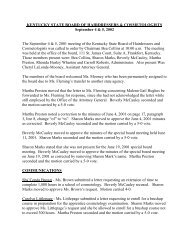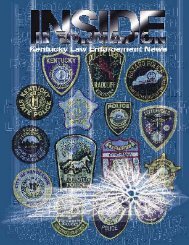Jan08 Advo.pmd - e-archives Home
Jan08 Advo.pmd - e-archives Home
Jan08 Advo.pmd - e-archives Home
You also want an ePaper? Increase the reach of your titles
YUMPU automatically turns print PDFs into web optimized ePapers that Google loves.
THE ADVOCATE Volume 30, No.1 January 2008<br />
Statements Made on Tape or Video – Most recorded interrogations include assertions from the<br />
officer that the defendant is not being truthful in some way. In Lanham v. Commonwealth, 171<br />
S.W.3d 14 (Ky.2005), the court ruled that the detective’s comments could be heard by the jury in<br />
order to provide the context of the defendant’s replies, but that the statements were not to be<br />
introduced to prove the truth of the matter asserted, and that the trial court should give a limiting<br />
admonition to that effect. In Fields v. Commonwealth, 12 S.W.3d 275, 279-82 (Ky.2000), the court<br />
ruled that in the case of a video recording of the investigation of a crime scene, the video portion<br />
was admissible but the audio voiceover, including the repetition of the defendant’s alleged<br />
confession, was hearsay. See also Fulcher v. Commonwealth, 149 S.W.3d 363 (Ky.2004), in which<br />
the court also ruled that the audio portion of the video was hearsay, but the defendant failed to<br />
object. Compare Brown v. Commonwealth, 2005 WL 387437 (Ky.2005), in which an expert<br />
commented on the contents of a video. When a tape, such as a recording of a drug deal, is partially<br />
inaudible, the court must decide whether the problems are serious enough to mislead the jury or<br />
make the entire piece of evidence untrustworthy. Gordon v. Commonwealth, 916 S.W.2d 176, 180<br />
(Ky.1995), Perdue v. Commonwealth, 916 S.W.2d 148, 155 (Ky.1995). An informant cannot act as an<br />
“interpreter” of the tape, clarifying inaudible sections as the tape is played. The witness must<br />
rather testify from memory, Gordon, supra, at 180. It is not within the discretion of a trial court to<br />
provide a jury with the prosecutor’s version of inaudible or indistinct portions of an audiotape.<br />
Sanborn v. Commonwealth, 754 S.W.2d 534 (Ky.1988), overruled on other grounds.<br />
Charts – Admission of a chart drawn by an absent informant was hearsay and reversible error.<br />
Cross-examination of the witness concerning the hearsay did not waive the objection to the<br />
admission of the evidence. Salinas v. Commonwealth, 84 S.W.3d 913 (Ky.2002). It was error for the<br />
court to admit into evidence police-created crime scene reconstruction diagrams through the<br />
testimony of an officer who had not been present at the scene at the time of the shooting and thus<br />
did not have personal knowledge of the locations of persons and items represented in the diagram.<br />
His testimony was investigative hearsay. Gosser v. Commonwealth, 31 S.W.3d 897 (Ky.2000).<br />
OBJECTIONS<br />
Legal Standard – Formerly, KRE (a)(1) only required an attorney to state the grounds of an objection<br />
“upon request of the court.” For years this was the rule in Kentucky and it was also consistent<br />
with RCr 9.22. Effective May 1, 2007, however, KRE (a)(1) was amended to read: “Objection. If the<br />
ruling is one admitting evidence, a timely objection or motion to strike appears of record, stating<br />
the specific ground of objection, if the specific ground was not apparent from the context.” So the<br />
best practice now is to state the grounds of the objection unless the context makes them obvious.<br />
Do not count on preserving error on appeal if you do not state the grounds of your objections.<br />
If the trial court denies counsel an opportunity to approach the bench and explain the objection, do<br />
it “[a]t the first reasonable opportunity to preserve the record.” Anderson v. Commonwealth, 864<br />
S.W.2d 909, 912 (Ky.1993).<br />
Purpose of – Appellate courts view objections as giving the trial court the opportunity to do the<br />
right thing. For example: “It is the duty of counsel who wishes to claim error to keep current on the<br />
law, and to object with specificity so that the trial judge will be advised on how to instruct. The<br />
underlying purpose of such a rule is to obtain the best possible trial at the trial level and to call any<br />
error to the attention of the trial judge, thereby affording him the opportunity to give the correct<br />
instructions.” Gibbs. v. Commonwealth, 208 S.W.3d 848, 854 (Ky.2006).<br />
And for example: “If there has been no motion for a directed verdict at the close of all the evidence,<br />
it cannot be said that the trial judge has ever been given the opportunity to pass on the sufficiency<br />
of the evidence as it stood when finally submitted to the jury.” Kimbrough v. Commonwealth, 550<br />
S.W.2d 525, 529 (Ky.1997).<br />
41<br />
NOTES


